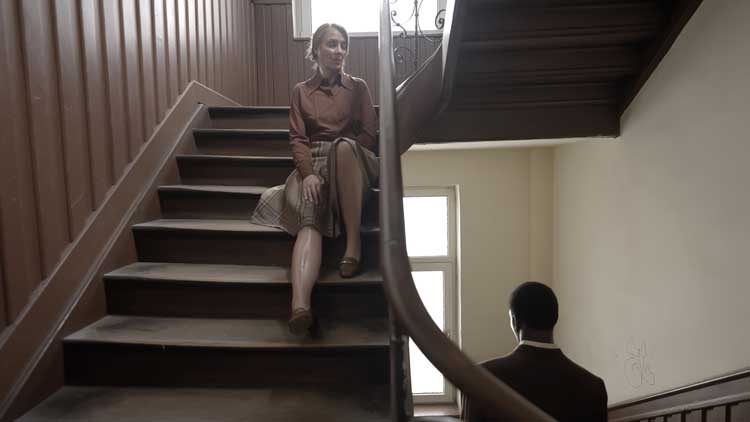-18.jpg)
Atiéna R. Kilfa, The Unhomely, installation view, Camden Art Centre, 2023. Photo: Rob Harris.
Camden Art Centre, London
27 January – 28 May 2023
by CHRISTIANA SPENS
The title of The Unhomely, Atiéna R Kilfa’s first UK institutional solo exhibition, is taken from Sigmund Freud’s term unheimlich, the German word that translates literally as “unhomely”, or something not from the home. Freud used the term to mean “uncanny”, but by focusing on and retranslating Freud’s original term, Kilfa reveals the importance of the concept of “the home” in what we think of as the uncanny. The eerie, dislocating sense of the uncanny, it is implied here, lies in a dissonance with the home, and with the family, who may or may not reside there, and in the tensions and confusions about belonging, home and how we organise our lives and identities around those ideas and the realities in which they are rooted.
-55.jpg)
Left to right: Atiéna R. Kilfa, NM11, 2023. Inkjet print to HP Gloss Photo Paper,
235 gsm, mounted to dibond, finished with a clear acrylic high gloss spray; 70.E1, 2023. Rotten epoxy hand, silk cuff, resin plug, led light, wood, acrylic glass. Courtesy the artist, Cabinet Gallery, London. Installation view of Atiéna R. Kilfa, The Unhomely, Camden Art Centre, 2023. Photo: Rob Harris.
The Unhomely, or as Kilfa puts it, this sense of interruption, strangeness and ghostliness, is rooted in a fear of that which is not from the home, especially, perhaps, when that thing – that strangeness – is also in one’s home. Kilfa reveals that this strangeness is also found in an absence of homeliness in the home; her structures, her architecture, is “of the home”, but there is a sense that any real sense of the familial, or at least its positive, warm iteration, is very much absent. In her creation, there are ghosts and creaks and confusion, but there is no family in the sense of love or belonging. Rather, there is a feeling of absence, and so of yearning. Kilfa has created a space in which to want and to mourn, but also to be bewildered: what is supposed to be here? What is “the home” supposed to feel like, as opposed to this, the unhomely? In this strangeness, we start to grasp at what home might be, what it could be, and yet the absence and strangeness here gives rise to a troubling anxiety, a fearfulness that it could be lost.

Atiéna R. Kilfa, The Landlords, 2022. Video still, courtesy the artist.
The figures in Kilfa’s video work involves a mannequin-like man and a woman in a stairwell, who seem not to connect or acknowledge one another, who give the impression of being ghosts, or perhaps one another’s ghosts, each in tension with the other, even avoiding the other, in their similar states of being not-quite-there. There is a sense of dissociation between them, as if they might not be living in the same time at all, as if they are two photographs of the same scene, overlaid.
-32.jpg)
Atiéna R. Kilfa, Déja Vu, 2023. 3D print and acrylic glass. Courtesy of the artist, Cabinet Gallery, London and Neue Alte Bruecke, Frankfurt. Installation view of Atiéna R. Kilfa, The Unhomely, Camden Art Centre, 2023. Photo: Rob Harris.
Kilfa takes inspiration from the aesthetics of 1970s cinema, and from architects’ models. As well as seeing this stairwell on the screen, which is effectively a wall of this almost-house, we also see a miniature model of the staircase. In the little version, the floorboards do not creak, and no ghostly figures stand. It is like seeing a dolls’ house of one’s own house, of being an Alice in Wonderland, unsure if we are supposed to be small, or the stairs are supposed to be big, not sure of what anything is supposed to be. Instead, there is this huis clos, a never-ending spiral in which we encounter “architectural ghosts” and also human-like ghosts, and ghosts of old films, and reconstructed floorboards, where we hear the echoes of our own steps and others’, where hundreds, perhaps thousands of other people have also walked, in this exhibition, but also wherever these floorboards were constructed before that. These floorboards are in a sense out of place, out of their original home, wherever that was. They were once trees, before that, wherever that was.
-66.jpg)
Atiéna R. Kilfa, 70.E1, 2023. Rotten epoxy hand, silk cuff, resin plug, led light, wood, acrylic glass. Courtesy the artist, Cabinet Gallery, London. Installation view of Atiéna R. Kilfa, The Unhomely, Camden Art Centre, 2023. Photo: Rob Harris.
This feeling is perhaps at the heart of the exhibition: if this is not quite how things are meant to be, then how should things be? What is right or normal or comfortable, what is home? What is the original place that things and people are from? What was home? These things, images and sounds are heavy with symbolic meaning to the point that they seem weary from it, beaten down like the old floorboards, as if they are lost in their own analysis, their own yearning for something increasingly intangible. I am not sure what the intention of the artist is, of course, but I cannot help but think that this exhibition plays out a weariness with psychoanalysis, or the feelings that spark such a practice or a search; “the unhomely”, this uncanniness, is perhaps accentuated by the search for meaning and origin, to the point where we are lost in a construction of shared symbols, a house haunted by ideas of what we need as much as what we may have lost.
• The Unhomely is co-produced in partnership with KW Institute for Contemporary in Berlin, where an iteration of the exhibition will be staged from 22 October 2023 until 15 January 2023.